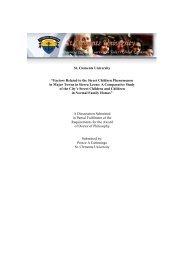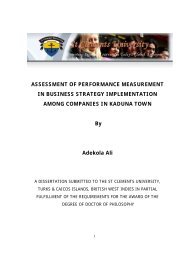The role of informal microfinance institutions in saving
The role of informal microfinance institutions in saving
The role of informal microfinance institutions in saving
You also want an ePaper? Increase the reach of your titles
YUMPU automatically turns print PDFs into web optimized ePapers that Google loves.
efore they adopt new technologies and make major farm <strong>in</strong>vestments. Assumptions<br />
concern<strong>in</strong>g lenders are that <strong><strong>in</strong>formal</strong> lenders exploitative and hence charge <strong>in</strong>terests<br />
rates that entail large element <strong>of</strong> monopoly pr<strong>of</strong>it”.<br />
(Adams and Graham 1984 <strong>in</strong> Sarris, 1966:6). Based on this k<strong>in</strong>d <strong>of</strong> th<strong>in</strong>k<strong>in</strong>g and reason<strong>in</strong>g<br />
rural f<strong>in</strong>ancial <strong><strong>in</strong>stitutions</strong> were expected to provide cheap and sometimes free credit for<br />
rural development. However, most rural f<strong>in</strong>ancial <strong><strong>in</strong>stitutions</strong> established <strong>in</strong> 1950’s and<br />
1960’s did not achieve planned objectives. Writers <strong>of</strong> the Ohio school and others have<br />
criticized <strong><strong>in</strong>stitutions</strong> that followed supply led approach. Low <strong>in</strong>terests rates, subsidized<br />
credit, poor loans process<strong>in</strong>g and delivery, centralized decision mak<strong>in</strong>g and bureaucracy<br />
have been cited as the major cause <strong>of</strong> failure <strong>of</strong> rural f<strong>in</strong>ancial <strong><strong>in</strong>stitutions</strong> performance <strong>in</strong><br />
develop<strong>in</strong>g countries.<br />
Credit enables small farmers and micro-enterprises to f<strong>in</strong>ance their development and<br />
<strong>in</strong>come generat<strong>in</strong>g activities. Moreover, issues which justify the need for credit to micro-<br />
enterprises and small farmers always limit small farmers and micro-enterprises access to<br />
credit. Levitsky and Prasad (1987: 1) suggest reasons which reduce small enterprises access<br />
to <strong>in</strong>stitutional f<strong>in</strong>ance due to lend<strong>in</strong>g to small enterprises is considered to be risky, banks<br />
and f<strong>in</strong>ancial <strong><strong>in</strong>stitutions</strong> are biased <strong>in</strong> favor <strong>of</strong> lend<strong>in</strong>g to large corporate borrowers, the<br />
adm<strong>in</strong>istrative costs <strong>of</strong> lend<strong>in</strong>g to small are always considered to be high, small enterprises<br />
seek<strong>in</strong>g loans are always perceived to be unable to provide account<strong>in</strong>g records and<br />
physical collateral.<br />
‘’<strong>The</strong> f<strong>in</strong>ancial <strong><strong>in</strong>stitutions</strong> can encourage efficient allocation <strong>of</strong> the stock <strong>of</strong> tangible wealth<br />
by br<strong>in</strong>g<strong>in</strong>g about changes <strong>in</strong> types <strong>of</strong> asset holders. Second, f<strong>in</strong>ancial <strong><strong>in</strong>stitutions</strong> can<br />
encourage efficient allocation <strong>of</strong> new <strong>in</strong>vestment by <strong>in</strong>termediation between savers and<br />
entrepreneur <strong>in</strong>vestors. Third, they can <strong>in</strong>crease the rate <strong>of</strong> accumulation <strong>of</strong> capital by<br />
provid<strong>in</strong>g <strong>in</strong>creased <strong>in</strong>centives to save, <strong>in</strong>vest and work’’ (Padmanabhan 1988:8). F<strong>in</strong>ancial<br />
<strong><strong>in</strong>stitutions</strong> can help small farmers and micro-enterprises to save, <strong>in</strong>vest <strong>in</strong> pr<strong>of</strong>itable<br />
ventures and <strong>in</strong>crease accumulation <strong>of</strong> capital for overall rural development and poverty<br />
reduction.<br />
180
















